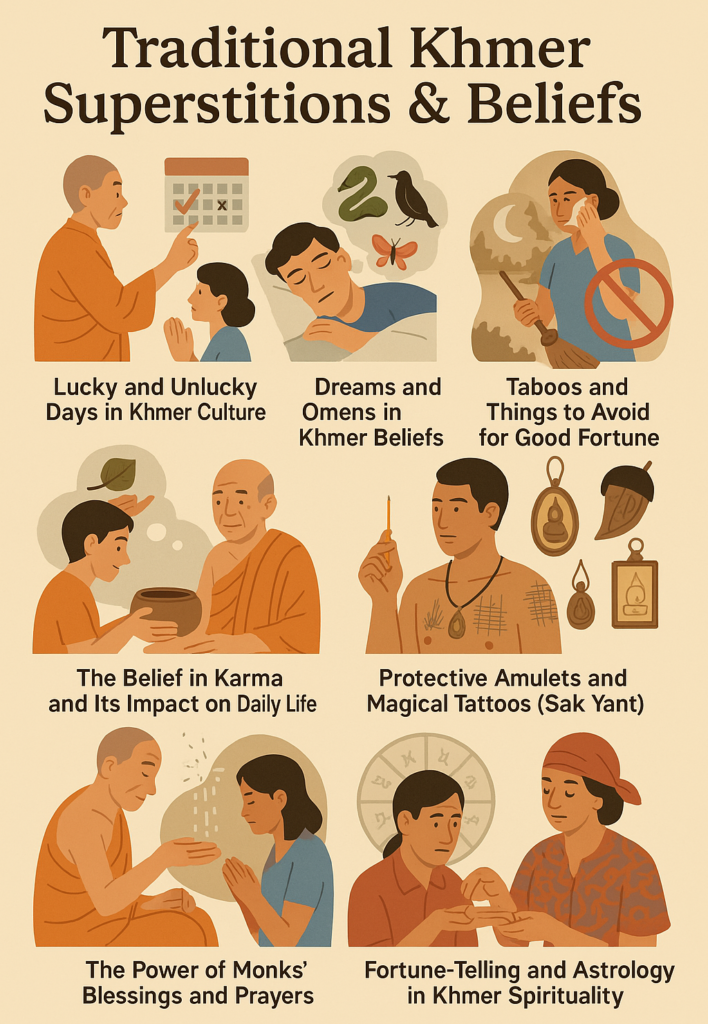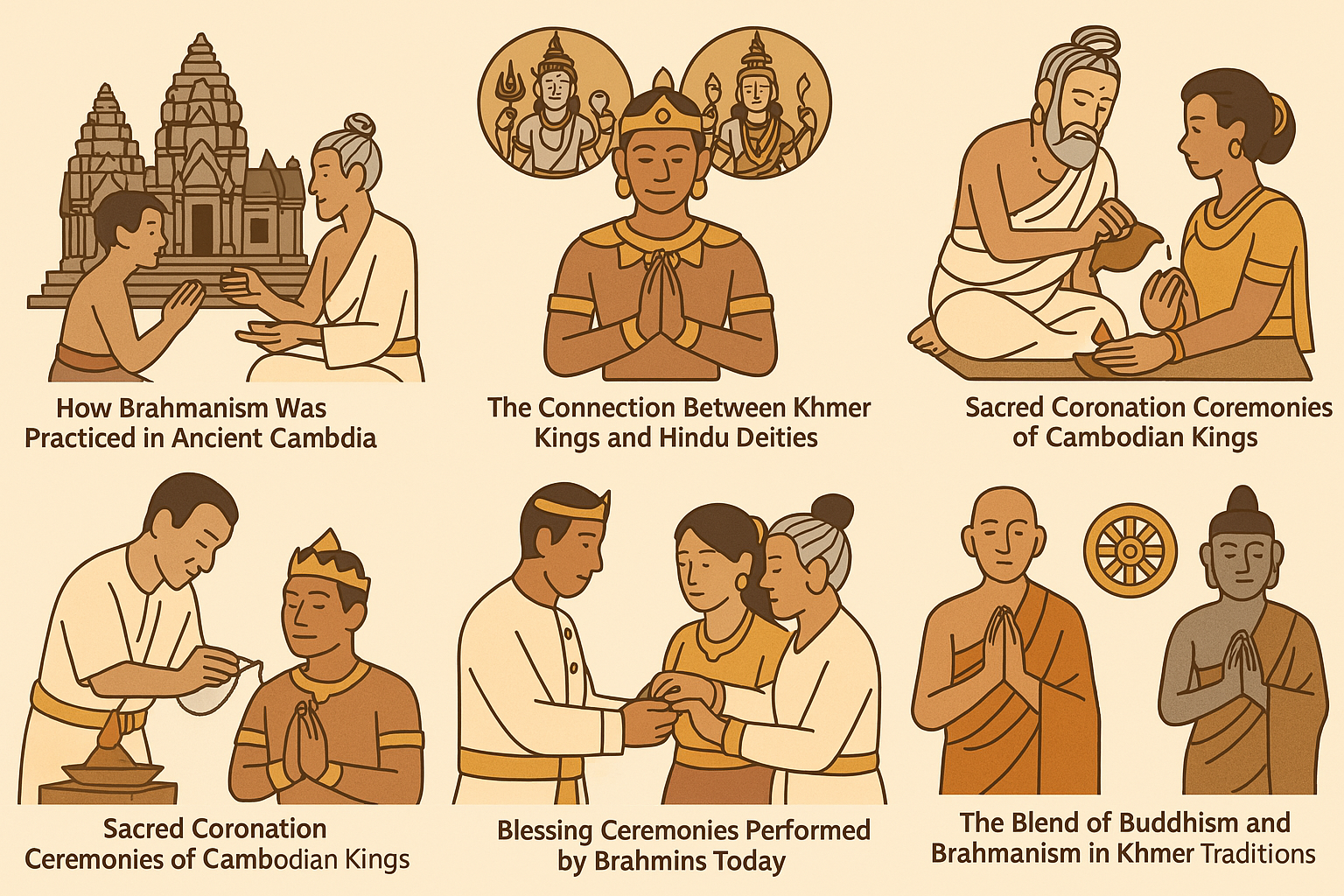Sacred Signs, Taboos, and the Unseen Threads of Cambodian Life
In Cambodia, ancient beliefs shape daily choices, from the days people marry to the colors they wear. While Theravāda Buddhism remains the nation’s primary religion, the everyday lives of Cambodians are steeped in superstitions, omens, astrology, and mystical practices. Passed down through generations, these beliefs reflect the Khmer worldview—a delicate balance between fate, merit, spirits, and the natural world.
They are not mere folk tales; they are part of a living, breathing culture that continues to guide how people interpret misfortune, pursue success, and make life decisions.

Lucky and Unlucky Days in Khmer Culture
In Khmer society, not all days are created equal. The calendar is filled with days considered especially lucky—or dangerously unlucky—for travel, marriage, childbirth, or even cutting one’s hair. These are often derived from a mix of Buddhist cosmology, Brahmanic astrology, and animist traditions.
Key Practices:
- Hor Khe (ហោរៈ): Khmer astrology guides important decisions based on lunar days, planetary positions, and zodiac signs.
- Auspicious Days for Weddings: Selected by monks or astrologers, usually after consulting the birth charts of both bride and groom.
- Unlucky Days (Thngai Kach): Certain days are believed to bring bad luck for major events or spiritual activity.
Even today, building a house or opening a business on the wrong day is considered risky, and many Cambodians won’t proceed without a monk’s or astrologer’s blessing.
The Significance of Dreams and Omens in Khmer Beliefs
Dreams are not just subconscious images in Khmer culture—they are messages from the spirit world, sometimes viewed as prophetic signs. Elders and monks are often consulted to interpret them, especially before major life events.
Common Beliefs:
- Dreaming of snakes may symbolize love or a future partner.
- Dreaming of teeth falling out is seen as a death omen in the family.
- Unusual animal sightings, like a black crow or owl near the home, are considered bad omens.
- Butterflies entering the house may foretell a visitor.
These beliefs are deeply rooted in the Khmer understanding of interconnectedness between the spirit realm and human destiny.
Taboos and Things to Avoid for Good Fortune
Khmer culture contains an extensive list of taboos (សៀម) designed to avoid angering spirits, attracting bad luck, or disrupting cosmic balance.
Notable Taboos:
- Don’t point at rainbows: Believed to bring bad luck or illness.
- Don’t sweep the house at night: It’s said to “sweep away good fortune.”
- Avoid sleeping with your head facing west: Associated with death.
- Do not cut nails or hair at night: Invites spiritual harm.
- Pregnant women should not attend funerals: To avoid malevolent spirits.
These taboos are especially strict during festivals, funerals, or periods of spiritual vulnerability, and are respected regardless of age or education.
The Belief in Karma and Its Impact on Daily Life
Central to both Buddhist teachings and Khmer ethics is the belief in karma (kam)—the spiritual principle of cause and effect.
In Everyday Practice:
- Good actions (merit-making) are believed to bring rewards in this life or the next.
- Harmful deeds are said to bring suffering or misfortune.
- Many Cambodians donate to monks, release animals, or help the poor to accumulate merit.
- Bad events are often attributed to past-life karma or recent moral transgressions.
This belief doesn’t lead to passivity, but rather motivates ethical living, generosity, and compassion.
Protective Amulets and Magical Tattoos (Sak Yant)
The desire for protection against unseen forces has given rise to powerful ritual items, especially amulets and Sak Yant tattoos.
Protective Amulets:
- Often blessed by monks or Kru Khmer.
- Carried for luck, health, love, or protection from harm.
- May contain relics, scriptures, or images of sacred deities.
Sak Yant Tattoos:
- Intricately designed sacred tattoos, often inscribed with Pali script, mystical animals, or geometric patterns.
- Believed to give strength, courage, charm, or invincibility.
- Must be blessed by a monk or traditional master to be effective.
- Wearers must follow a moral code, or risk losing the tattoo’s power.
These sacred markings and items symbolize the intersection of spiritual belief, identity, and personal protection in Khmer life.
The Power of Monks’ Blessings and Prayers
Monks are seen as channels for spiritual power, and their blessings are highly sought in all areas of life. Whether it’s a newborn, a newlywed couple, or a new home, monks play a vital role in providing ritual protection and spiritual guidance.
Common Blessing Ceremonies:
- Tak Baat: Daily morning alms rounds—people believe giving food to monks brings great merit.
- Water Blessing (Srot Tep): Holy water is sprinkled to cleanse negativity and attract good fortune.
- Thread-Tying (Sien Don Bai): Monks tie red or white threads around wrists for protection and well-being.
These blessings are believed to purify karma, protect from spirits, and bring peace of mind, reflecting the deep trust Cambodians place in monastic power.
Fortune-Telling and Astrology in Khmer Spirituality
Even in the modern era, divination practices remain popular. Whether it’s before a wedding, job interview, or business launch, many Cambodians turn to fortune-tellers or astrologers for advice.
Common Practices:
- Palm Reading (Bai Chet): Interpreting lines of the hand.
- Horoscope Readings (Rahu Chart): Using one’s birth time and date to predict fate.
- Card or dice readings often done by lay fortune-tellers.
- Some use divination bowls or rituals involving candles and incense.
These predictions are taken seriously, and major life decisions are often delayed or advanced based on a seer’s advice.
Conclusion: Spiritual Threads Woven into Everyday Life
Khmer superstitions and traditional beliefs are not merely old customs—they’re part of a worldview where spirit, karma, and unseen forces are inseparable from daily life. They reflect a profound respect for the unknown and a desire to live in harmony with the natural and spiritual worlds.
In a fast-changing Cambodia, these beliefs remain resilient, whispered between generations, etched into tattoos, worn around necks, or consulted under candlelight—quiet reminders that in Khmer culture, the mystical is always close at hand.





